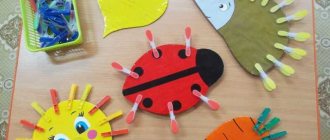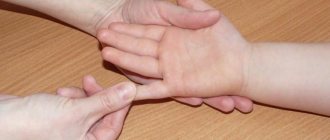Many parents know that from an early age it is very important to develop fine motor skills in a child, since this is directly related to the development of speech. Special educational toys can be bought in the store, or you can make them yourself by reading our article today, in which we have collected interesting DIY ideas for creating such toys. All you need is a little time and some household items that you were probably going to throw away. In addition, your baby will definitely like a toy made by mother’s hands and will be a useful tool for him.
Sorter
A sorter is a box into which you put various figures. It helps develop attention and perseverance in a child. Inserting figures into holes of appropriate shape and size develops fine motor skills and trains the eye. In addition, during the game, the child becomes familiar with various geometric shapes, colors and sizes of objects. We liked the funny sorter in the shape of an elephant, which you can make yourself from what you have on hand.
DIY toys
Toys for developing and improving fine motor skills can be made from improvised means and unnecessary items at home.
Board
Busy board is an innovation among educational toys. It is a small piece of MDF, chipboard, with locks attached to them, dials from old telephones, bells, switches and other small parts that are interesting to touch and unscrew.
The stand for developing fine motor skills is so captivating for infants that they explore it for several hours a day.
Important! Do not attach sharp objects or glass fragments to the board. They can hurt the baby.
Soft cube
Suitable for babies from 6 months of age. It is sewn from pieces of multi-colored fabric and decorated with appliqués. You can embroider letters and numbers on them. Pyramids and houses are made from soft cubes; they can be thrown and crushed.
Soft books play the same role. They can be made from fabric, appliques in the form of fairy-tale characters.
Bags of cereals
Sew a fabric bag from a dense, pleasant-to-touch material. The size of the toy should correspond to the age of the baby. For one-year-old babies - 6x6 cm, for older children from 10 cm in width, 8-10 cm in length.
Sew it on three sides, leaving the fourth open. Fill the bag with any cereal: rice, buckwheat, beans. Fingering toys is a fun pastime for all kids.
Important! Periodically check the quality of the seams, make sure that the filler does not spill out and that beans do not get into the babies’ mouths.
Happy snake
Make a rope out of fabric, or sew the material together in several layers in the form of a sausage. Attach many buttons of different sizes, shapes, and textures to it with a thread. The kids sort them out, feel them, trying to pick them off. This is how hand strength and finger motor skills develop.
Knitted toys
Suitable for infants and children up to 3 years old. Mothers knit toys in the form of animals and dolls. You can put clothes on them, make eyes out of buttons for them. Use threads of different colors and textures. It is important for the baby to feel the heterogeneity of the material.
Books
This is a whole didactic complex. The number of pages depends on the imagination, patience and hard work of the parents. To create it you will need pieces of A4 size fabric, padding polyester, pieces of multi-colored material, buttons, zippers and everything you can find for creativity at home.
You can create entire compositions on the pages of the book to develop fine motor skills. For example, figures of animals, fish, on others - create landscapes, stick on applications of numbers and letters. Nothing limits mom's imagination.
It is important to understand the purpose of creating such a manual for the development of motor skills. Glue laces with beads, zippers, and ribbon loops onto the page of the book. You can use buttons and Velcro to unfasten elements so that the baby can attach them himself during play, developing motor skills and learning self-service at the same time.
Volume book
For the early development of a baby, books are often used, with which you can play and develop various skills. Look what an amazing soft toy book Olga made with her own hands! A little imagination and creativity - and you too can do something similar.
Tactile bags
You can make several small fabric bags, filling them with various contents: cereals, beads, rice.
What you will need:
- textile;
- threads, needle;
- scissors;
- contents - cereals, rice, beads, beads.
Operating procedure:
- Cut out several small pillows and carefully stuff each one with cereal, just make sure the contents are different. For example, one will contain only rice, the other will contain oatmeal, etc.
- Sew an additional large fabric bag for them where you will store homemade toys.
- What to stuff? There are many options: shells, rice, cotton wool, pebbles, beads. The main thing is that the objects are smooth and safe.
Soft cube
Kids love to play with bright, colorful blocks. And if the cube is made of fabric and has all kinds of ribbons, pockets, jingles and rustles, then this is not just a toy, but an excellent educational aid! You will find a detailed master class on sewing such a cube here.
Games with cereals
Suitable for toddlers from six months old, the main thing is to make sure that they don’t put them in their mouth. The little ones can simply sort out and pour buckwheat, rice, peas, and for older children you can come up with real didactic activities, during which they will become familiar with the concepts of “big - small”, “higher - lower”, names of animals, sorting rules, etc.
"Gather the Chickens"
Prepare a container or large box, cereal, tongs (spoon, clothespin).
Game options:
- bury small objects and ask the child to find them;
- place small elements on the chicks' rump that can be sorted according to some characteristic or fed;
- if there are no such toys, take animal figurines and let the baby find a cow (“Who says “Moo-oo”), a chicken (“Who says “Ko-ko-ko”), etc.;
- You can also write letters, numbers and shapes on the rump with your finger.
Drawing with rice
Coating rice with food coloring creates a unique painting medium. Apply glue to the paper and ask your child to sprinkle the cereal.
This activity will be useful for finger motor skills, color perception and imagination.
Developmental mat
Another teaching aid that helps make your baby’s fingers more dexterous and skillful is a soft developmental mat. It could be a themed rug, where an entire city is drawn as an appliqué, each house or tree has a different texture, and you can actively play with the figures. Olga has a great idea for such a rug on her blog. And at the Masters Fair we noticed some very cool rugs from master Galina. Filled with inspiration and ideas, you can make a truly unique rug for your child, with which he can not only play, but also develop.
Laces
These are book toys, cardboard figures or a set of objects that can be tied together with a cord. While playing, kids develop motor skills, logic, thinking, attention, and coordination.
Laces are made of cardboard and wood. Small holes are made in objects through which a thick thread is threaded. The order of action is not important at first. The main thing is that the child learns to put the lace into the hole, and then connect several objects on one thread.
Baby sling beads and bracelets for babies
These toys are more suitable for babies to chew and feel. You can’t always trust the assortment in stores; there is no guarantee of the safety of the products. And at home you can make them yourself using step-by-step instructions.
These are the earliest toys that look like beads or bracelets. Mothers often wear them to distract the baby while he is in a sling or in his arms.
Important! This will require crocheting skills. The ability to tie objects (bracelets, beads) and knit individual elements (animal figures, soft balls).
What you will need:
- wood beads;
- cotton threads;
- hooks;
- waxed cord/ribbon (base);
- filler (silicone fiber, cotton wool);
- rustling or any rattling objects (if necessary).
Operating procedure:
Decide in advance whether it will be a small bracelet, full-fledged beads or a biting toy. The base is a wooden object.
Bracelet - toy
Option 1. Take a small wooden ring and carefully tie it so that the knitted fabric covers the entire surface. In a similar way, tie a small wooden bead - the “head” of the toy. Separately tie a pair of ears to it, decorate the muzzle. When finished, connect the parts.
Option 2. Here wooden balls alternate with soft, knitted ones. You can tie several wooden balls - beads or tie balls, stuffing them with cotton wool/foam rubber. Let soft balls alternate with ordinary wooden ones in the bracelet. Connect them by using a thick, cotton thread.
Option 3. A bracelet with different balls is complemented by a pair of wooden rings.
Option 4. Bracelet - hippo. Tie a wooden base bracelet with cotton thread, just tighter and secure the ends. Tie the 4 legs and head of the hippopotamus separately. Fill them with cotton wool or other soft filler.
Option 5. Multi-colored knitted balls are collected together, with a figurine of a small hippopotamus. Tie each ball separately. You can use multi-colored threads to make the toy brighter. When collecting ready-made balls, alternate them with small beads. Sew a knitted animal figurine in the center.
INTERESTING: How to make a lacing toy
Sling beads are made in a similar way, only they are larger. Mom wears such a practical aid for the baby, at the same time a distracting thing.
Such toys are also suitable for one-year-old children, 1-2, even 1-3 years old. Over time, you can complicate the structure of the beads or bracelet by explaining to your child exactly what elements it consists of.





